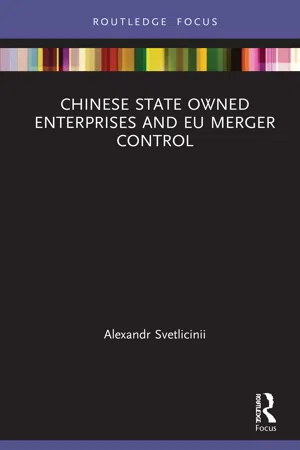
Chinese State Owned Enterprises and EU Merger Control
Alexandr Svetlicinii
- 134 pages
- English
- ePUB (adapté aux mobiles)
- Disponible sur iOS et Android
Chinese State Owned Enterprises and EU Merger Control
Alexandr Svetlicinii
À propos de ce livre
This book analyzes the specifics of corporate governance of China's State Owned Enterprises (SOEs) and their assessment under EU merger control, which is reflected in the EU Commission's screening of the notified economic concentrations.
Guided by the going global policy and the Belt and Road Initiative, Chinese SOEs have expanded their global presence considerably. Driven by the need to acquire cutting edge technologies and other industrial policy considerations, Chinese SOEs have engaged in a series of corporate acquisitions in Europe. The main objective of this book is to demonstrate the conceptual and regulatory challenges of applying traditional merger assessment tools in cases involving Chinese SOEs due to the specifics in their corporate governance and the regulatory framework under which they operate in China. The book also explores the connection between the challenges experienced by the merger control regimes in the EU and the recent introduction of the EU foreign direct investment screening framework followed by a proposal concerning foreign subsidies.
The book will be a useful guide for academics and researchers in the fields of law, international relations, political science, and political economy; legal practitioners dealing with cross-border mergers and acquisitions; national competition authorities and other public bodies carrying out merger control; policy makers, government officials, and diplomats in China and the EU engaged in bilateral economic relations.
Foire aux questions
Informations
1
State owned enterprises under the EU merger control
1.1 State owned enterprise as ‘undertaking’ or ‘person’ under the EU merger control
Table des matières
- Cover
- Half Title
- Title Page
- Copyright Page
- Contents
- Preface and acknowledgments
- List of abbreviations
- 1 State owned enterprises under the EU merger control
- 2 China’s state owned enterprises: governance and regulation
- 3 Economic concentrations of China’s state owned enterprises under the EU merger control regime
- 4 From merger control to foreign investment screening in the European Union
- Conclusion
- Annexes
- Index